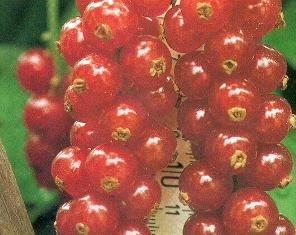Currant Production in Manitoba
Description


There are many different types of currants (Ribes spp.) including red (R. rubrum L.), black (R. nigrum L.), and white. Currants belong to the Saxifrage family. The red and black types are preferred compared to the white. Many different cultivars of red and black currants have been produced. These vary in time of fruit bearing, disease and insect tolerance, and plant size.
Currants are small deciduous shrubs which are native to Canada. Red currants range in size from three to five feet (0.9 to 1.5 m) and black currants to five feet (1.5 m ) and taller. Many of the cultivated varieties grown in commercial plantings are European varieties introduced to Canada.
Currants produce flowers on one-year-old shoots and contain eight to 30 buds. Cross pollination is not necessary in red currants but is required for black currants. Cross pollination results in significant yield increases in red currant yields.
Currants are very hardy and can withstand winter temps of -22 to -31°F(-30 to -35°C). The flowers are tolerant to frost and can withstand temperatures between 31 and 28°F (-0.5 to 2.0°C) when open and 27 to 23°F (-3 to -5°C) when closed. The small fruit is tolerant to temperatures between 28 and 27°F (-2 to -3°C).
Uses
Currants are used in industrial processing for jam, juice, jelly, drinks and syrup. They are also eaten fresh in fruit salads or other desserts.
Site Selection/ Spacing/Rooting Depth
Currants require a well-drained, deep loam soil which contains greater than one percent organic matter. Currants grow best in a soil pH between 5.5 and 7.0. Black currants should be planted four to five feet (1.25 to 1.5 m) apart with 10 to 12 ft (3 to 3.5 m) between rows. Red currants should be planted three to four feet (1.0 to 1.35 m) apart with 8 to 9 ft (2.4 to 2.7 m) between rows. Distances between rows can be reduced if fruit is to be hand harvested. Currants are shallow-rooted; with the roots primarily located in the top eight to 16 in. (20 to 40 cm) of the soil. The spread of the root system does not usually extend beyond the canopy of the plant.
Harvesting/Nutritional Value
Black currants take some time after planting until fruit production begins, but should produce for at least 10 years. Red currants take some time after planting to begin producing fruit and have a production life of 15 to 20 years. The fruit is usually ripe at the end of July to early August. Currants do not have a long shelf life keeping one to two days at room temperature and up to seven days, if refrigerated. The compact size of the plant makes it possible to use mechanical harvesting. Hand-held picking machines also work well.

